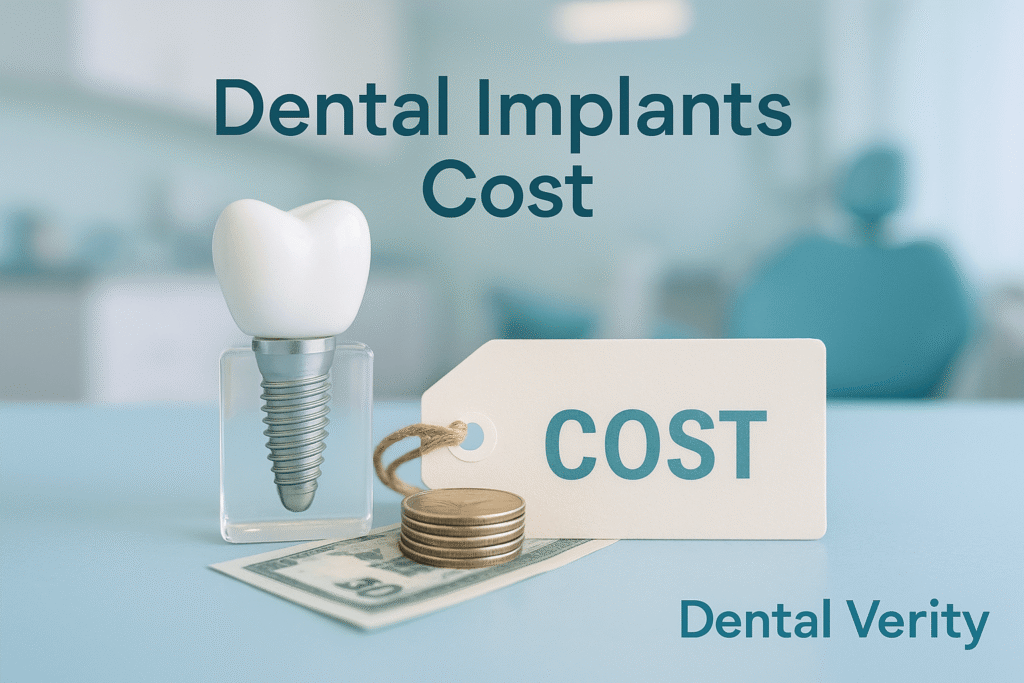
You might find yourself hiding your lips when you smile, maybe because of a missing tooth that’s been damaged for years, always snagging on an apple skin or other foods. In moments like that, dental implants can be the key to permanently transforming your smile into one you’re truly happy to share, one that feels natural. In the U.S., the average adult between the ages of 20 and 64 has about three missing or decayed teeth, and nearly 17% of people age 65 and older have lost all their natural ones, often due to injury, gum issues, or disease. So if you have one or more teeth gone, remember you’re definitely not alone.
What Exactly Are Dental Implants?
Dental implants are man-made and designed to be a permanent replacement for a tooth and its roots. Doctors create these artificial supports by surgically attaching a screwlike post into the jaw, where they become artificially rooted and permanently attached. Once secure, they can hold teeth, crowns, bridges, or even dentures, whether you need a single, several, or all replaced. Because they fit, feel, and function so natural, they’re often a great option if you have missing, damaged, or chronic dental problems. They don’t just look good they actually help restore your bite too.
Materials Used in Dental Implants
An implant is typically made of titanium alloy, a metal as strong as steel but lighter in weight, resistant to corrosion, and completely nontoxic, biocompatible, and safe for the body. Each one has three parts: the implant body, the abutment, and the crown. The cost can run into the thousands of dollars, and the total depends on the number of teeth you need to replace, where they’re located, and other factors like insurance coverage. If your plan doesn’t fully cover it, you may still find ways to save money but one thing’s certain, the stability and strength of a titanium implant body make it worth considering.
Different Types of Dental Implants You Can Choose From
When your dentist explains the options for dental implants, you’ll see that the common types are made to fit different needs. Here are some of the best choices you might select:
• Single tooth implant perfect if you need to replace one missing tooth
• 3-on-6 three bridges supported by six implants
• All-on-4 used for a full arch of teeth with four implants
• Immediate-load gives you new teeth the same day
• Implant-supported bridge helpful when several teeth are missing in a row
• Subperiosteal placed under the gum but above the bone, often chosen when bone height is limited
What Does a Dental Implant Really Cost?
The national average cost for a single dental implant is about $2,143, though it can range between $1,600 and $4,200. This price usually includes the implant placement and materials, but the crown is billed separately, costing between $500 and $3,200.
In many cases, however, the total cost of a single implant typically falls between $3,000 and $7,000, depending on case complexity or additional procedures. A newer option, one-piece zirconia ceramic implants, generally look more natural but usually cost a few hundred dollars more than titanium.
Key Things That Influence the Cost of Dental Implants
The price of dental implants isn’t a simple one size answer. They’re usually customized to match your needs, and several factors can affect what you end up paying.
• Geographic location matters. Your city or state can change what professionals charge, with bigger cities often having higher costs of living
• Insurance coverage helps with some major procedures. Check your dental insurance plan, though some things like Medicare may leave you paying out of pocket
• The number of implants. A single one is less than multiple or implant-supported bridges
• The location in your mouth can add challenges, sometimes needing sinus surgery
• The type of implant. Titanium is the most common and cost-effective material, while zirconia is a newer technology that’s usually more expensive
• Complexity of the procedure such as tooth extractions, bone grafting, or treating health conditions like periodontal gum disease
• The expertise of your specialist. Whether it’s a general dentist, oral surgeon, or periodontist, experience can raise the bill if the case is more complex
Extra Expenses You Might Face with Dental Implants
Beyond the price of the implant device and its surgical placement, there are other expenses that can add up. Here are some common ones people often don’t expect:
• Dental exams, X-rays, and evaluations may cost between $200 and $450, especially if you’re uninsured
• Bone grafting is a procedure with an average cost of about $600; the graft site needs time to heal before the implant can be placed
• A sinus lift to improve bone thickness in the upper jaw can add $1,500 to $2,500 to your bill
• Anesthesia varies — sedation can be around $50 to $200, while general anesthesia by an anesthesiologist may run several hundred dollars per hour
• Specialist care from oral or maxillofacial surgeons often comes with a higher charge than general dentists, especially for complex procedures involving implants
Will Your Insurance Help with Dental Implant Costs?
Many people wonder if dental insurance providers will actually help with the cost of implants. The truth is, it depends on the plans, the type of procedure, and what your provider decides is covered. Here are a few things to keep in mind:
• Some insurance companies see implants as an elective procedure, so only parts like the crown, body, or abutment may be included
• Private policies may cover up to 50% of certain major procedures, but usually have an annual maximum of about $1,500
• Medicare Original typically excludes dental care, but Medicare Advantage may add preventive benefits; Medicaid varies by state and programs, sometimes offering comprehensive or diagnostic coverage if considered medically necessary
• Your dentist or dentistry office can give an overview of your plan, help you review the rules, and explain what expenses you’ll need to pay out of pocket
• For uncovered parts, some practices offer payment options, and many accept CareCredit, a credit card that makes it more convenient to pay over time
• Coverage can also depend on whether the implant helps maintain or restore the health of your teeth and gums, or if it’s only a cosmetic fix
Why Do Dental Implants Come with a High Price?
The high price of a dental implant often reflects more than just the materials used. The overall cost includes the process itself, the placement and healing, and the complexity of each case. Because the full treatment can take several months from start to finish, the length of time adds to why this careful dental work comes at a higher value.
Are Dental Implants Really Worth the Investment?
Many people worry that dental implants are too expensive, but for many, they turn out to be a worthwhile investment. If you’ve lived with missing teeth, you know how chewing can be difficult, and how remaining teeth may shift or move into the empty space, causing bite misalignment. Replacing dentures or bridges with implants often feels more durable and comfortable, even compared to partial options.
• Healing may take longer if you have diabetes, leukemia, low estrogen, or another health condition, and smoking (as shown in a study in the Journal of Clinical Periodontology) raises the risk of implant failure, especially with heavy cigarettes use.
• Problems like a broken screw or loosened abutment can happen, sometimes leading to a short-term issue where the bone doesn’t heal and a graft or second attempt is needed.
• Long-term concerns may come from chronic gum infections, and symptoms like discomfort or bleeding might require the removal of the implant.
Pros of Dental Implants
Choosing a dental implant can bring many benefits to your everyday life. It helps with restoring a missing tooth, giving back both function and appearance. It also supports long-term health by preserving your jawbone and gums, while preventing nearby teeth from moving out of place.
Cons of Dental Implants
On the other hand, there are potential risks with a dental implant. These can include damage to nearby teeth, gums, sinuses, jawbone, or nerves during implantation. There’s also a chance of infection in the bones, issues like misalignment, or even color mismatch that affects the final look.
Helpful Questions to Ask Your Dentist About Implants
When you’re consulting a dentist, oral surgeon, periodontist, or even an endodontist about an implant procedure, it’s always smart to ask clear questions so you understand the costs, benefits, and risks. Here are some you might bring up during your visit:
• How many implants have you performed, and what’s your success rate?
• What steps are required for my procedure, and what will the costs look like?
• Are there any unexpected expenses or treatments I should prepare for?
• How much recovery time will I need, and will it mean missing work?
• What is your recommended approach, and how do the benefits compare with the risks?
Getting Dental Implants: Step by Step
The journey of getting dental implants is a multistep process that usually takes a few months. Your dentist, along with an oral surgeon or care team, will guide you through each stage to make sure you get the right choice and kind of treatment.
• Consultation where your dentist and team discuss the best plan for you.
• Preparation of your mouth which may involve removing damaged teeth or tissue, then clean and sterilize the area; sometimes an extraction with local anesthesia or sedation is needed.
• The procedure where a small incision is made in the gum, an opening is created in the jawbone, and the implant with its artificial root is placed and the area is sealed.
• Healing period where your doctor lets you recover before placing permanent crowns; in some case-by-case situations, a temporary crown may be added sooner.
Possible Side Effects and Healing After Dental Implants
After dental implants surgery, it’s normal to expect some short-term side effects while your body works to recover over a few months. Most of these are mild and improve with proper care.
• Minor bleeding in the first days is common
• Risk of infection at the site if not cleaned well
• Temporary swelling around the gums and jaw
• Possible nerve or sinus irritation that may cause discomfort
• Small chances of tissue damage, though this is rare and usually treatable
What Are Some Alternatives to Dental Implants?
If you’d like to avoid the expense or the long wait that sometimes comes with implants, there are other options your doctor may suggest to help replace missing teeth. Each has its own cost, materials, and downside, so it’s worth exploring carefully.
• Dental bridges can fill gaps between adjacent teeth using false teeth anchored by abutments; prices usually range from $2,000 to $5,000, and they often need crowns on the healthy supporting teeth.
• Dentures, whether partial or full, are removable artificial replacements held by adhesive against your gums; they can cost from $800 to $3,100 depending on the type, size, and device used.
• Some patients expect a surgical procedure if teeth are decayed or damaged before fitting; while these prosthetics can replace lost teeth, research shows most last about 10 years before needing an update.
• Dentures are fitted to the contours of your mouth, but compared to implants, they may cause issues with comfort over months and could even lead to gum irritation or swelling if not adjusted properly.
Conclusion
While the cost of dental implants may feel high, they are truly a long-term investment in your oral health. Unlike temporary fixes, implants restore function and confidence for years to come. It’s always best to consult your dentist to understand your options, compare costs, and choose the treatment that fits your needs.



